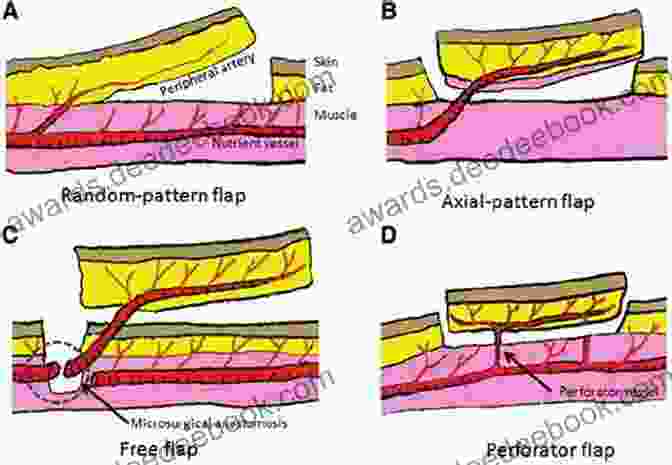Duke Flap Course Dissection Guide: Unlocking the Secrets of the Workhorse Flaps

In the realm of reconstructive surgery, the workhorse flaps reign supreme. These versatile flaps are indispensable for a vast array of procedures, offering surgeons unparalleled precision and versatility. Among these workhorses, the Duke flap stands out as a legend, renowned for its reliability and effectiveness.
This comprehensive guide will delve into the intricacies of the Duke flap dissection, providing a step-by-step roadmap to mastering this surgical technique. Armed with this knowledge, surgeons can unlock the full potential of the Duke flap, empowering them to achieve exceptional outcomes in their reconstructive surgeries.
5 out of 5
| Language | : | English |
| File size | : | 3667 KB |
| Print length | : | 942 pages |
| Lending | : | Enabled |
| Screen Reader | : | Supported |
Anatomy of the Duke Flap
The Duke flap is a transposition flap based on the superficial branch of the radial artery. It is located on the volar forearm and consists of skin, subcutaneous tissue, and the underlying fascia.

- Skin: The skin of the Duke flap is thin and pliable, making it ideal for use in delicate facial and hand surgeries.
- Subcutaneous tissue: The subcutaneous tissue of the Duke flap is relatively sparse, allowing for easy dissection and mobilization.
- Fascia: The underlying fascia of the Duke flap provides a strong and stable base for the flap, ensuring its integrity and durability.
Blood Supply
The Duke flap is supplied by the superficial branch of the radial artery, which runs along the radial border of the forearm. This artery gives off numerous perforating branches that supply the skin and subcutaneous tissue of the flap.

The perforating branches are typically located within 1-2 cm intervals, ensuring a reliable blood supply to the entire flap. This abundant vascularization contributes to the Duke flap's exceptional survival rates and resistance to ischemia.
Advantages of the Duke Flap
- Reliability: The Duke flap has a proven track record of success, with high survival rates and minimal complications.
- Versatility: The flap can be used to reconstruct a wide range of defects, including those in the face, hand, and trunk.
- Thin and pliable: The thin and pliable nature of the flap makes it ideal for use in delicate facial and hand surgeries.
- Excellent color match: The skin of the Duke flap often matches the surrounding skin well, resulting in an aesthetically pleasing outcome.
- Minimal donor site morbidity: The donor site of the Duke flap is typically small and easily concealed, minimizing the impact on the patient's overall appearance.
Duke Flap Dissection Guide
The dissection of the Duke flap is a meticulous procedure that requires careful attention to detail. This step-by-step guide will walk you through the essential steps of the dissection.
Step 1: Patient Positioning
The patient is positioned supine with the arm abducted and externally rotated. A tourniquet is applied to the upper arm to minimize bleeding during the dissection.
Step 2: Incision Planning
The incision is planned along the radial border of the forearm, extending from the wrist crease to approximately 5 cm proximal to the elbow. The incision should be centered over the superficial branch of the radial artery.
Step 3: Skin Incision and Flap Elevation
The skin is incised along the planned incision line. The skin and subcutaneous tissue are elevated as a single flap, taking care to preserve the underlying fascia.
Step 4: Identification of the Superficial Branch of the Radial Artery
The superficial branch of the radial artery is identified along the radial border of the forearm. The artery is typically found within 1-2 cm of the fascia.
Step 5: Ligation of the Perforating Branches
The perforating branches of the radial artery are ligated to minimize bleeding and ensure the viability of the flap.
Step 6: Subfascial Dissection and Elevation of the Flap
The subfascial dissection is performed, freeing the flap from the underlying structures. The flap is elevated as a single unit, including the skin, subcutaneous tissue, and fascia.
Step 7: Closure of the Donor Site
The donor site is closed primarily using interrupted sutures. A skin graft may be required if the donor site is large.
Variations of the Duke Flap
There are several variations of the Duke flap that can be used to address specific surgical needs.
Reverse Duke Flap
The reverse Duke flap is a modification of the traditional Duke flap where the blood supply is reversed. This technique is used to reconstruct defects on the dorsum of the hand and wrist.
Extended Duke Flap
The extended Duke flap is a longer version of the traditional Duke flap that can be used to reconstruct larger defects. This variation requires the ligation of additional perforating branches of the radial artery.
Clinical Applications of the Duke Flap
The Duke flap has a wide range of clinical applications in reconstructive surgery.
Facial Reconstruction
The Duke flap is commonly used in facial reconstruction surgeries, including those involving the nose, lips, and eyelids. Its thin and pliable nature makes it ideal for delicate facial procedures.
Hand Reconstruction
The Duke flap is also frequently used in hand reconstruction surgeries, including those involving the fingers and thumb. Its versatility and durability make it a reliable choice for reconstructing complex hand defects.
Trunk Reconstruction
The Duke flap can also be used to reconstruct defects on the trunk, including those in the chest, abdomen, and back. Its large size and excellent color match make it suitable for reconstructing larger defects in these areas.
The Duke flap is a versatile and reliable workhorse flap that has earned its place in the arsenal of reconstructive surgeons. Its exceptional survival rates, ease of dissection, and wide range of clinical applications make it an indispensable tool for surgeons seeking to achieve optimal outcomes in their patients.
By following the steps outlined in this guide, surgeons can master the Duke flap dissection technique and unlock the full potential of this surgical workhorse.
5 out of 5
| Language | : | English |
| File size | : | 3667 KB |
| Print length | : | 942 pages |
| Lending | : | Enabled |
| Screen Reader | : | Supported |
Do you want to contribute by writing guest posts on this blog?
Please contact us and send us a resume of previous articles that you have written.
 Book
Book Page
Page Chapter
Chapter Reader
Reader Paperback
Paperback Magazine
Magazine Newspaper
Newspaper Paragraph
Paragraph Sentence
Sentence Bookmark
Bookmark Shelf
Shelf Glossary
Glossary Foreword
Foreword Synopsis
Synopsis Footnote
Footnote Bestseller
Bestseller Library card
Library card Narrative
Narrative Biography
Biography Autobiography
Autobiography Memoir
Memoir Character
Character Resolution
Resolution Librarian
Librarian Catalog
Catalog Card Catalog
Card Catalog Borrowing
Borrowing Stacks
Stacks Periodicals
Periodicals Study
Study Research
Research Journals
Journals Interlibrary
Interlibrary Literacy
Literacy Study Group
Study Group Thesis
Thesis Dissertation
Dissertation Storytelling
Storytelling Awards
Awards Reading List
Reading List E J Braswell
E J Braswell Kristina Borjesson
Kristina Borjesson Thom Powell
Thom Powell Graham Yuill
Graham Yuill Cat Porter
Cat Porter Linda Melvern
Linda Melvern Will Stockton
Will Stockton Historian S Office Wyoming County Ny
Historian S Office Wyoming County Ny Lara Neel
Lara Neel Ron Field
Ron Field David E Newton
David E Newton John Pirillo
John Pirillo Kelli Worrall
Kelli Worrall Elie Acin
Elie Acin Peter Lovrick
Peter Lovrick Nick Spalding
Nick Spalding Nicola Carroll
Nicola Carroll Tammy R Vigil
Tammy R Vigil Max Lerner
Max Lerner John K Fulton
John K Fulton
Light bulbAdvertise smarter! Our strategic ad space ensures maximum exposure. Reserve your spot today!

 Franklin BellUnveiling the Enchanting World of Chinese Opera: A Journey into the Actor's...
Franklin BellUnveiling the Enchanting World of Chinese Opera: A Journey into the Actor's...
 Michael CrichtonRock Out with the School of Rock Easy Piano Songbook: A Comprehensive Guide...
Michael CrichtonRock Out with the School of Rock Easy Piano Songbook: A Comprehensive Guide... Hayden MitchellFollow ·11.4k
Hayden MitchellFollow ·11.4k Jeremy MitchellFollow ·2.3k
Jeremy MitchellFollow ·2.3k Roald DahlFollow ·10.8k
Roald DahlFollow ·10.8k Art MitchellFollow ·2.1k
Art MitchellFollow ·2.1k Harvey HughesFollow ·17.5k
Harvey HughesFollow ·17.5k Junot DíazFollow ·3k
Junot DíazFollow ·3k Isaac AsimovFollow ·18k
Isaac AsimovFollow ·18k Brett SimmonsFollow ·7.1k
Brett SimmonsFollow ·7.1k

 Roger Turner
Roger TurnerThe Waning of the Individual in the Global Era: A...
In the rapidly globalizing world of today,...

 Reginald Cox
Reginald CoxFirst of Verbs: An Early Language
The First of Verbs (FOV) is an early...

 Cody Blair
Cody BlairThe Biography Of The Myth: Routledge Historical...
Who is the Myth?...

 Dean Cox
Dean CoxArtificial Neural Networks: Unraveling the Amazing...
Artificial Neural Networks (ANNs),...

 Kyle Powell
Kyle PowellHow To Amend Our Constitution To Rescue Democracy For All...
Our democracy is in...
5 out of 5
| Language | : | English |
| File size | : | 3667 KB |
| Print length | : | 942 pages |
| Lending | : | Enabled |
| Screen Reader | : | Supported |










